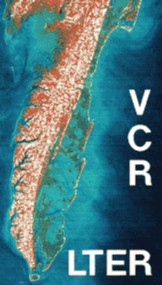 Interactions Between Geomorphology, Hydrology, and Vegetation on Southern Parramore Island |

R. Craig Kochel
Department of Geology
|
 Interactions Between Geomorphology, Hydrology, and Vegetation on Southern Parramore Island |

R. Craig Kochel
Department of Geology
|
Since 1993 a network of benchmarks and shallow piezometers have been periodically monitored to document the evolution of landforms along a segment of southern Parrmore Island. The study region, which is part of a multi-island long-term system of monitored overwash sites, includes a major pimple, two washover fan sites, and an exceptionally dynamic beach area located approximately 2 km northeast of Quinby Inlet. The Parramore study site is a major focus of our long-term effort to investigate the relationships between coastal processes (including tides, storm surge, waves, and precipitation) to the evolution of island landforms such as washover fans, dunes, and pimples. Wells at this site are used to provide information on depth to groundwater and groundwater quality data such as salinity. The primary objective of the project is to determine linkages between disturbance stress, such as overwash, drought, wet periods, etc., and the evolution of landforms and vegetation. Quarterly topographic profiles at the site have documented major island responses to significant storms and non-storm periods alike. Overwash events characteristically flatten island landforms such as dunes, flatten the beach, erode sand from the beach, and pile sand up in the interior and backbarrier environments. Periods between major overwash events are characterized by dune building on berm and washover fan areas, elevation of the oceanward sectors of the island, and increases in vegetation density.
Initial studies on the hydrology of the site show significant variations in depth to water table and salinity between island subenvironments. Water tables are generally shallow on washover fans where salinities range between 5 - 12 ppt. Backbarrier marsh environments typically have water tables at the land surface and have groundwater salinities above 25 ppt, sometimes well into the hypersaline realm. Dunes generally have the greatest depth to water table, commonly in excess of 1-2 m and groundwater quality is generally fresh, with salinities below 3 ppm. Likewise, pimples show significant depth to the water table and generally experience fresh conditions. Investigations of pimple hydrology (summarized by senior theses of Farleigh 1996 and Berntsen 1995) showed variations in pimple groundwater tables at a variety of scales, including: 1) daily evapotranspiration and tidal fluctuations, 2) monthly tidal fluctuations, and 3) irregular but major responses to significant overwash events. Groundwater salinity also varied with overwash events and precipitation history.
We just launched a major effort this summer to increase our understanding between the groundwater hydrology, landform evolution, and island vegetation. The site is currently being mapped on a several-cm scale using GPS Survey technology. The resulting topographic map will serve as the base for additional data layers to be collected in 1997. These layers will include: 1) sediment characteristics, 2) depth to water table, 3) groundwater salinity, 4) vegetation species, and 5) vegetation density. This detailed mapping should allow us to improve our understanding of the dynamic relationships between hydrology, landforms, and vegetation on a low-profile barrier island. Additionally, this work will serve as a base-line for future tracking of the Parramore site in response to climatological and overwash stress. Already, we have documented approximately 20 m of shoreline erosion of the fans and pimples from the 1996-97 storm season, a season without any major extratropical storms. Approximately 50% of the pimple, including one full line of monitoring wells and much woody vegetation was eroded between GPS Surveys in October 1996 and May 1997. Groundwater salinity in the former mid-pimple region increased from 2 ppt to 23 ppt as the result of the shoreline erosion as the proximity of the shoreline encroaches on to the pimple.
Additional work is in progress in 1997 to investigate these same relationships on an island-wide scale on Myrtle Island. Myrtle Island is the site of intensive small-mammal research and is also a site where extensive adjustments in landform evolution has been occurring during the past year. We plan to establish baseline GPS mapping, vegetation surveys, and salinity maps for the entire northern half of Myrtle Island for comparison to the more detailed investigations of a smaller scale on Parramore Island.
Berntsen, J., 1995, Hydrogeomorphic and vegetative relationships on low-profile barrier islands, Virginia Coast Reserve. Senior Thesis, Bucknell University, Department of Geology.
Farleigh, K., 1996, The influence of overwash events on the hydrology and vegetation of a pimple on Parramore Island, Virginia Coast Reserve. Senior Thesis, Bucknell University, Department of Geology.